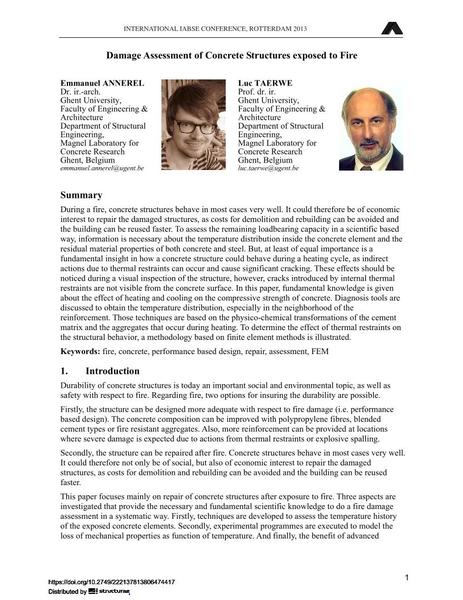Damage Assessment of Concrete Structures exposed to Fire

|
|
|||||||||||
Bibliografische Angaben
| Autor(en): |
Emmanuel Annerel
Luc Taerwe |
||||
|---|---|---|---|---|---|
| Medium: | Tagungsbeitrag | ||||
| Sprache(n): | Englisch | ||||
| Tagung: | IABSE Conference: Assessment, Upgrading and Refurbishment of Infrastructures, Rotterdam, The Netherlands, 6-8 May 2013 | ||||
| Veröffentlicht in: | IABSE Conference, Rotterdam, May 2013 | ||||
|
|||||
| Seite(n): | 112-113 | ||||
| Anzahl der Seiten (im PDF): | 8 | ||||
| Jahr: | 2013 | ||||
| DOI: | 10.2749/222137813806474417 | ||||
| Abstrakt: |
During a fire, concrete structures behave in most cases very well. It could therefore be of economic interest to repair the damaged structures, as costs for demolition and rebuilding can be avoided and the building can be reused faster. To assess the remaining loadbearing capacity in a scientific based way, information is necessary about the temperature distribution inside the concrete element and the residual material properties of both concrete and steel. But, at least of equal importance is a fundamental insight in how a concrete structure could behave during a heating cycle, as indirect actions due to thermal restraints can occur and cause significant cracking. These effects should be noticed during a visual inspection of the structure, however, cracks introduced by internal thermal restraints are not visible from the concrete surface. In this paper, fundamental knowledge is given about the effect of heating and cooling on the compressive strength of concrete. Diagnosis tools are discussed to obtain the temperature distribution, especially in the neighborhood of the reinforcement. Those techniques are based on the physico-chemical transformations of the cement matrix and the aggregates that occur during heating. To determine the effect of thermal restraints on the structural behavior, a methodology based on finite element methods is illustrated. |
||||
| Stichwörter: |
Beton FEM Reparatur Bewertung Brand
|
||||
